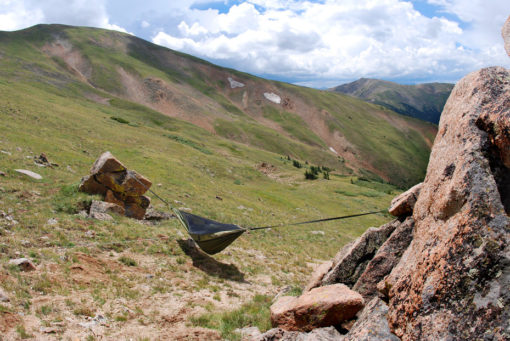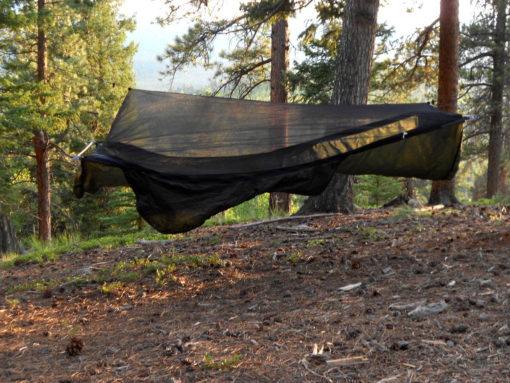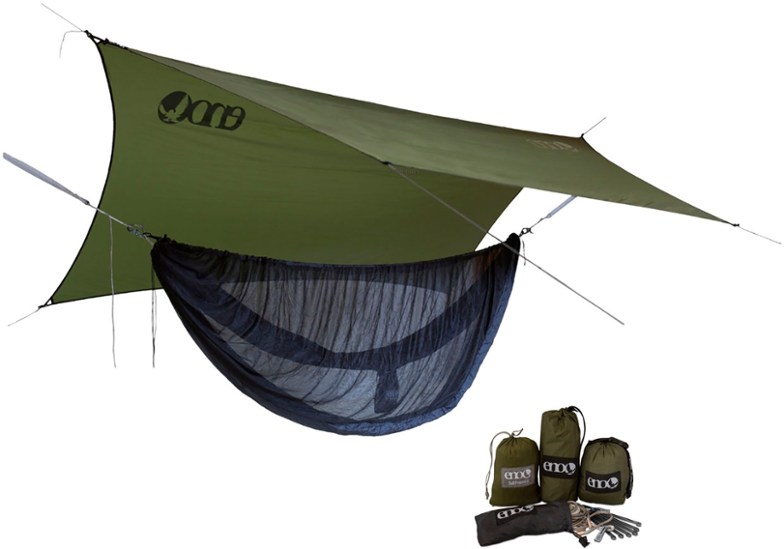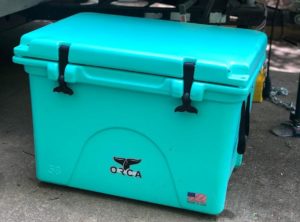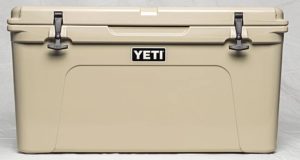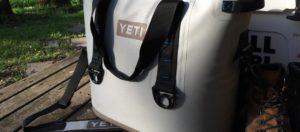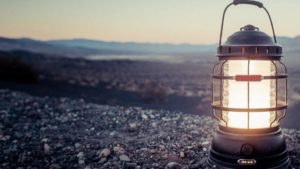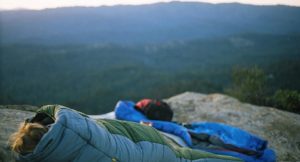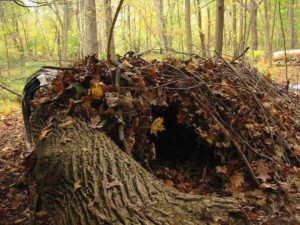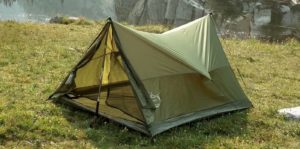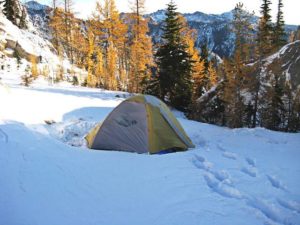Hung up on which hammock? We can help. We researched over 50 of the most popular models and tested the best 11 side-by-side for 100+ hours of testing. Our expert testers brought them camping in a variety of environments, from the high desert in winter to wet mountains in spring, to see how they compared. We measured them based on a variety of metrics, searching for the most comfortable and lightweight contender. What we found was that any camper, from ultralight backpackers to budget car campers, will find the perfect product in our review. Each model was high quality, but a few hung above the competition. Read on to pick your perfect hammock.
Best Overall Hammock: Warbonnet Blackbird
Pros
- Includes suspension and bug net
- Easy to set up and adjust
- Comfortable
- Feature rich
Cons
- Carabiners and stakes not included
- Bug net is not removable
- Can take time to find the “sweet spot”
For varied terrain and weather, we found that the best model for backcountry camping was the Warbonnet Blackbird. It’s a combination of ultralight material, features and comfort put it above the other products reviewed and secured its status as our first pick. While there are a few models we reviewed that are lighter, we felt that the Blackbird best balanced all aspects of a superior hammock specific camping experience. With only the essentials, its weight can be as low as 20 ounces. Considering the integrated bug net, we feel that this weight is reasonable. Adding the easily adjusted whoopee sling suspension saves even more weight and makes getting the perfect hang that much easier. Warbonnet offers the Blackbird in two different fabric choices and with an optional double floor. We chose to test the Blackbird with a couple of accessories: the Yeti underquilt and Mambajamba tarp. While these items definitely upped the Blackbird’s game, even without the add-ons this is a superior setup.
Best Bang for your Buck on a Tight Budget: Grand Trunk Ultralight Starter
Pros
- Affordable
- Comfortable
- Lightweight
Cons
- Limited durability and protection
- Cheaper fabric
Camping on a budget has never been easier, thanks to the affordable, lightweight Grand Trunk Ultralight Starter. Weighing in at 12.6 ounces, this product is not only a great value, at $20, but a reasonable option for ultralight camping. You will need to either purchase or make a suspension system, but even with that added expense, this is a deal. We found other models to be more comfortable and some features we prefer to have were missing, like durable and stretchy parachute nylon fabric, but for a camper looking to not break the bank, this is the best choice of the models tested.
Top Pick for Side Sleeping: Warbonnet Ridgerunner
- Spreader bars allow you to lay flat
- Integrated bug net
- Suspension included
- Double layer bottom
- Carabiners not included
- Heavy
- Flat design can tip over more easily
Many double models and asymmetrical models are great for getting a flat-diagonal lay and facilitate a good side lay, at least on one side. But if you want to flip over to the other side, you might be met with a face full of fabric if you don’t switch your diagonal to the other direction. It includes a suspension system, so you’re good to go right out of the bag.
Top Pick for Ultralight Versatility: ENO SubLink Shelter System
- Lightweight
- Stuff sack doubles as a pillow
- Package includes suspension, bug net, and rain fly
- Narrow
- Made of thin material
You will be light on your feet and ready for any scenario with the ENO SubLink Shelter System with Sub7. The Sub7 is the lightest model tested, weighing in at 6.4 ounces. That is downright impressive and had to be rewarded. The SubLink Shelter System we added as an upgrade contains suspension, a bug net, and a rain fly. Altogether, it’s not the lightest package, but each component individually is the lightest ENO offers, from the 4.1-ounce Helios Suspension System to the 16-ounce ProFly Sil Rain Tarp (the heaviest component). You can pick and choose what you need and leave the rest at home with this setup. Going out for just one summer night and trying to keep your weight down? Bring just the hammock and suspension. Going into potentially inclement weather? Bring it all. This setup will allow you to customize your adventure, staying lightweight at the same time.
We’ve taken 11 of the most popular contenders into varied weather and terrain to help you decide what’s best for you. We evaluated each product for comfort, weight, versatility, ease of set-up, and protection/durability. Based on the scores pulled from the individual reviews, we’ve calculated a score for each.
Types of Hammocks
The 11 models we reviewed fell into four main categories:
Open Models
These are models with a single- or two-person capacity, an open boat-shaped design, and integrated suspension system attachment points (e.g., S-hooks, carabiners, etc.). The double versions are longer and wider than their single counterparts and are great for couples to sit and lounge in, though they only comfortably sleep one. Doubles are also an excellent option for larger campers or people who just want more space.
All of these models, whether single or double, tend to be fairly inexpensive, decently lightweight, and durable. Generally, they do not include a suspension system and you will have to choose and purchase that separately. Models that fall into this category are the ENO Reactor, ENO DoubleNest, Grand Trunk OneMade Double Trunktech, and the Kammok Roo.
Ultralight Models
These are weight cutting options for backpackers looking for the lightest setup available in order to shave ounces from their pack. These models are usually less comfortable and less durable than a regular single hammock but are perfect for the right scenario. In this category, we evaluated the Grand Trunk Ultralight Starter, Grand Trunk Nano 7, Hennessy Ultralite Backpacker Asym Zip, and the ENO Sub7. However, the Sub7 was evaluated as part of the SubLink Shelter System which fits more appropriately in the next category, expedition models, as does the Hennessy Ultralite Backpacker.
Expedition Models
These are burly setups designed to withstand a variety of conditions and extended stays. Many of them offer a more comfortable, asymmetrical design. They often come with features, like rain flys and bug nets, and will be heavier and more expensive than open designs. In this category, we tried the Warbonnet BlackBird, Warbonnet Ridgerunner, Hennessy Expedition Asym Zip, Hennessy Ultralite Backpacker Asym Zip, and the ENO SubLink Shelter System.
Depending on conditions, all of these models can be utilized for camping and backpacking, though we make note of the ones that are specifically marketed and particularly suited for that purpose.
Check out our Buying Advice article for an in-depth look at how the features of different models translate into a camping experience and what style will work best for you.
Our full test suite this time around included 11 hammocks plus accessories. Shown off to the right here is the Mambajamba tarp and Yeti underquilt for the Blackbird as well as the spreader bars for the Ridgerunner.
How We Chose
Comfort
Comfort is the most important quality we scored because models that sleep uncomfortably are obviously not ideal for camping. Bigger models usually are more comfy to sleep, while the lighter designs sacrifice comfort and can often affect your quality of sleep. Each model was tested with a sleeping pad and sleeping bag. See our reviews for the best sleeping bags and pads for high quality, lightweight options that will pair well.
An additional component of comfort that is often overlooked or difficult to decide on when internet shopping is fabric type. The models with the softest, most supple fabric were the ENO Reactor, Kammok Roo, and Grand Trunk OneMade Double Trunktech. The Grand Trunk Ultralight Starter had the stiffest fabric of all the models we tested, which is part of why we gave it a 6 out of 10 in this category. Not a huge surprise when you’re only spending $20. If you plan to be wrapped up in a sleeping bag, this isn’t a big deal, but it’s something to keep in mind if you will be napping in your short shorts.
Sleep is among the most personal things we do and comfort is subjective, so this is a difficult metric to assess. Much like choosing a mattress, pillow, or sleeping bag, remember that we each have very particular criteria for getting our ZZZs, so take our ratings here with a bit of healthy skepticism and spend time thinking about what aspects of a rejuvenating rest are the most critical for you.
Overall, smaller campers will find that more models fit them and larger campers will prefer roomier designs. We felt that there were no double models that slept a pair comfortably, though larger doubles fit two loungers better than a single, and slept one very comfortably. All of that considered, we still had to pick some winners and losers from the perspective of our astute testers.
The Warbonnet Blackbird sports an asymmetrical design, an interior side shelf, and a foot box — a winning combination that allows for a roomy diagonal lay. We tested the Blackbird along with an underquilt and tarp that allowed us to feel protected and warm. The Warbonnet Ridgerunner is the only model tested that came with spreader bars, allowing you to widen it into more of a cot shape. This feature made it the best model for side or stomach sleeping, so we awarded it a Top Pick just for that! The Reactor is an open design with soft fabric and cozy double-thickness floor, which creates a sleeve for your sleeping pad.
The model we found the least comfortable was the Grand Trunk Nano 7. Just slightly more comfortable were the Sub7 and the Grand Trunk Ultralight Starter. You might notice a running theme with the competitors we deemed less comfortable: They are all ultralight models. Not surprisingly, models with thin fabric and narrow dimensions aren’t as cozy as their heavier, roomier counterparts.
The unique addition of spreader bars on the Ridgerunner creates a wider flatter sleeping surface that allows for more a more comfortable side lay.
Weight
There was a wide variation in weight between hammocks. Our value for the weight metric includes the hammocks themselves and anything attached to them (such as carabiners), and a stuff sack (if included). Suspension systems, such as tree straps, were not included in the weight unless the manufacturer specifically included the suspension in the same stuff sack. Many of the models tested did not come with a suspension system, and the weight of your final setup is therefore contingent on the system you choose to implement.
The ENO Reactor weighs a smidge under 27 ounces and it’s only the hammock — no suspension, no bug net — so we scored it a 5. It’s cozy and insulated with a double layer of fabric to create a sleeve for your sleeping pad, but if you end up needing a tarp or bug net, be prepared to carry as much or more weight as a backpacking tent.
The lightest model tested, the ENO SubLink Shelter System, clocked in at a featherweight 6.4 ounces. To put that in perspective, it’s about half the weight of a full can of soda, and we thought that deserved a 10 rating. Granted, we tested the Sub7 as part of a shelter system (a package upgrade that ENO offers for all of its hammocks), and that system weighed in at the high end of the pack at 44.3 ounces.
As for complete expedition setups, the heaviest was, again, the Expedition Asym Zip at 49.2 ounces, and the Blackbird, along with the accessories we decided to add on. The Blackbird with the Mambajamba Tarp and Yeti Underquilt weighs in at 49.7 ounces. The lightest expedition setup tested was, by far, the Hennessy Ultralite Backpacker Asym Zip, at 33.6 ounces, and we gave it an 8 out of 10. However, if you consider the Blackbird 1.1 Single Layer without the accessories, it’s 20-ounce weight is very competitive. It doesn’t include a tarp as the Hennessy models do, but it does have an integrated bug net.
Ease of Setup
For hanging a hammock you need a suspension setup, and many models don’t come with it. We saw a clear divide here between expedition and non-expedition models. All of the expedition models tested, the Blackbird and Ridgerunner by Warbonnet, the Ultralite Backpacker and Expedition by Hennessy, and the ENO SubLink Shelter System with Sub7, came with suspension systems. The rest of the models tested, all open designs, did not include suspension. These open-design models were all the easiest to set up once the suspension issue was figured out, requiring only clipping the included carabiners or S-hooks to your anchor. The Kammok Roo came with the burliest carabiners, along with Dyneema slings, climbing-grade components that, while perhaps overkill, can pad your climbing rack in a pinch!
The expedition models required more know-how when setting up, for a number of reasons. Not only are there various suspension systems to contend with, but full setup also requires putting up a tarp and, in some cases, an extra ridgeline. None of the Warbonnet models come with carabiners, and both the Warbonnet and Hennessy models lack stakes, so some forethought is needed before heading out. The SubLink Shelter System with the Sub7 also requires setting up the bug net, which isn’t attached to the hammock body as it is with the Warbonnet and Hennessy models.
If you were setting one of these up for the first time at the end of a long day or in the dark, chances are you would be frustrated or overwhelmed.
The presence or absence of a suspension system is an important thing to consider when looking at the price of these models. All the manufacturers offer at least one option for suspension sold separately, starting at $20-30. While we gave the Grand Trunk Ultralight Starter our Best Buy Award for being a great beginners model for only $20, consider that you will need to double that price if you want a ready-to-go system from the manufacturer. If you’re willing to put in a little research, however, you can create a suspension system yourself with rope or webbing that will cost less. This makes the initial learning curve a bit more involved, though. If you take this route, we ask that you know how to create a safe system and also how to properly protect the trees you plan to use.
Bottom line, the models that didn’t come with a suspension were all easy to set up once you’ve dealt with that issue, and the models that did come with suspension required a bit more practice and tweaking for us to feel efficient and competent. Most of the manufacturers have helpful videos and advice on their websites, and YouTube is also a great resource.
Protection and Durability
The best protection was offered by the Warbonnet Blackbird with accessories, so we awarded it a 9. The design offers an integrated bug net and deep floor to cut the wind from flowing into it. When paired with a tarp and underquilt, you have a functional and protective setup. This system isn’t cheap though, running $170 for the single layer hammock by itself and $485 when you add the tarp and underquilt.
Our other top choice for this metric was the Hennessy Expedition Asym Zip, also scoring a 9. The fabric feels burlier to the touch and for $180 you get both the hammock with integrated bug net and a tarp. The tarp isn’t as wide as the Mambajamba from Warbonnet so you may have to get crafty in certain weather situations, but it’s adequate.
A couple of other models worth mentioning here are the ENO Reactor and the Warbonnet Ridgerunner. The Reactor offers two thick layers of fabric, which provide a sleeve for your sleeping pad. Even without a pad in place though, when the wind blew we barely felt it through the luxurious double layer of fabric. It’s still an open model with no bug net or tarp though, so we gave it a 6. The Ridgerunner also offers a double floor for a sleeping pad as well as an integrated bug net, which bumped it scores up to an 8.
Versatility
Your setup should be versatile enough to accommodate all of your needs. This will obviously vary from person to person. For a lot of users, being able to hide from the weather and sleep well isn’t quite enough — people are drawn to a hammock for reading, napping, and lounging around, both alone and with a buddy. For these users, a double model like the ENO DoubleNest, ENO Reactor, or Kammok Roo is a great purchase. You can sit up or lay down, pile kiddos in, or pitch it under a tarp in crappy weather. And if you are indeed camping out, there are plenty of accessories — from top quilts to underquilts to bug nets — that can be purchased separately to diversify and enhance your setup. Sometimes you can even combine accessories across brands to construct a flexible campsite.
Specialty items, like tiny ultralight models made from a super thin fabric, don’t lounge or accommodate a friend very well, thus limiting their versatility. Expedition models with bulky infrastructures are great for backpacking but can also be difficult to share or sit up in due to bug nets and asymmetrical designs. We found that the features making the Hennessey and Warbonnet models comfortable and bug-proof also made them complex to set up and almost impossible to share with a friend. Be sure to consider what products have the features that are best for your intended use, and try to think outside the box. Is being able to sit up important for you? What about being able to share the space with another person? Keep in mind all aspects of what brings you the most pleasure when hanging around in the great outdoors.
Our top pick in the versatility category was the ENO SubLink Shelter System with Sub7, which we gave a score of 9 out of 10. This package does come with a narrow ultralight hammock, but we loved how all the components are separate and can be used according to your needs. The stuff sack is also fleece-lined, giving it the awesome feature of doubling as a pillow when you turn it inside out! It is worth noting that if we had evaluated the Sub7 by itself without the shelter system, it would have scored at the bottom for this category, as our other ultralight models did (the Nano 7 and the Ultralight Starter were both given a 4). With thin fabric and not much width, there’s simply not much versatility to be had for these models by themselves.
ENO also offers these shelter systems for any of their products, so if weight isn’t an issue, you can get all of the same features with a heavier and larger model.


